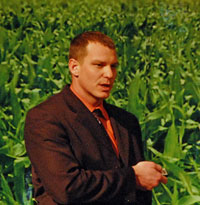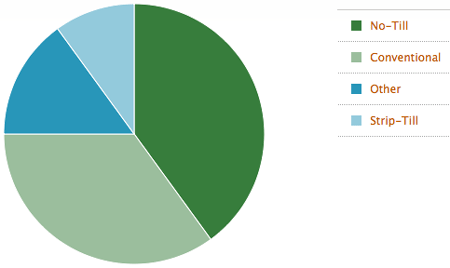 Clemson University entomologists created a nice visual demo field that shows the value of Bt cotton compared to non-Bt.
Clemson University entomologists created a nice visual demo field that shows the value of Bt cotton compared to non-Bt.
The furry-looking insects start their development smaller than the head of a pin, but the caterpillars soon develop an appetite for cotton as big as the crop.
To demonstrate the insects’ destructive power, Clemson University entomologist Jeremy Greene planted two cotton varieties — one genetically modified to provide protection from caterpillars, one not — in a demonstration field at the Edisto Research and Education Center.
The non-protected cotton was planted in a pattern that spelled the word “Tigers.” Aerial photographs taken near harvest show that while the genetically modified crop survived intact, the unprotected plants provided three square meals a day for the crop-hungry herbivores.
The demonstration crop was planted in late May last year and grew through the summer.
“We wanted to show the kind of damage caterpillars can do when they’re allowed to eat unprotected cotton freely,” Greene said.
Cotton is a multimillion dollar crop in the Palmetto State involving hundreds of farms and thousands of jobs.
Nearly all cotton varieties planted in South Carolina contain genes found in the naturally occurring Bacillus thuringiensis, or Bt, that help the plant make its own insecticide.
Bt cotton is genetically modified with specific genes from Bacillus thuringiensis. Think of it as in-plant insecticide, Greene said. This technology has been commercially available since 1996, but improvements over the years have enhanced the control of major pests.
The plant makes the proteins just like the bacterium does. The particular strain of Bacillus thuringiensis available in cotton, which was planted for the demonstration, works only on immature lepidopterans, or caterpillars. Lepidoptera is the insect order for moths and butterflies. The toxic proteins have no ill effects on other organisms.
“During 2010, we had a very high population of bollworm that infested cotton acres at the Edisto research center,” Greene said. “We planted a non-Bt variety where you see the word ‘Tigers’ and a two-gene Bt cotton where you see the fluffy white cotton lint.”
The striking difference in appearance is due to bollworms eating all of the green cotton bolls in the non-Bt variety that did not have protection from the insects.
Greene applied no insecticides to control caterpillars in this field, so the difference between the Bt and non-Bt varieties is illustrated clearly.
A color-coded yield map, produced by precision agriculture specialist Will Henderson at the Edisto center, illustrates the crop after harvest using one of the center’s pickers that is equipped with a yield monitor. The map shows “good” yields in green and “bad” yields in red.
The damage potential of important lepidopteran species, such as bollworm, is not new, Greene said. Moths have flown into fields, laid eggs and hatched as injurious caterpillars for decades.
Transgenic Bt technology and its improvement over the years are relatively recent advances that represent effective, economical and environmentally friendly control of these insects in agriculture, he said.
“We know what they can do to non-Bt cotton versus Bt cotton — the photographs speak for themselves,” Greene said.
 At the recent Holdrege Water Conference in Nebraska, several speakers talked about how precision technology is not only conserving water but saving growers money as well, according to this Nebraska TV report.
At the recent Holdrege Water Conference in Nebraska, several speakers talked about how precision technology is not only conserving water but saving growers money as well, according to this Nebraska TV report.
 At the recent GROWMARK
At the recent GROWMARK  Dr. Vince Davis discussed how it takes a total management approach to increase soybean yields. “In soybeans, increasing yields is a really tough game to get into,” Vince told me. “About 10 bushels, 9 and a half bushels an acre is about what we were able to obtain in our large plots, and that’s about what I’ve seen as a maximum level that we can increase. If you can put up 10 extra bushels at $13 beans, that’s a lot of extra money.”
Dr. Vince Davis discussed how it takes a total management approach to increase soybean yields. “In soybeans, increasing yields is a really tough game to get into,” Vince told me. “About 10 bushels, 9 and a half bushels an acre is about what we were able to obtain in our large plots, and that’s about what I’ve seen as a maximum level that we can increase. If you can put up 10 extra bushels at $13 beans, that’s a lot of extra money.”










